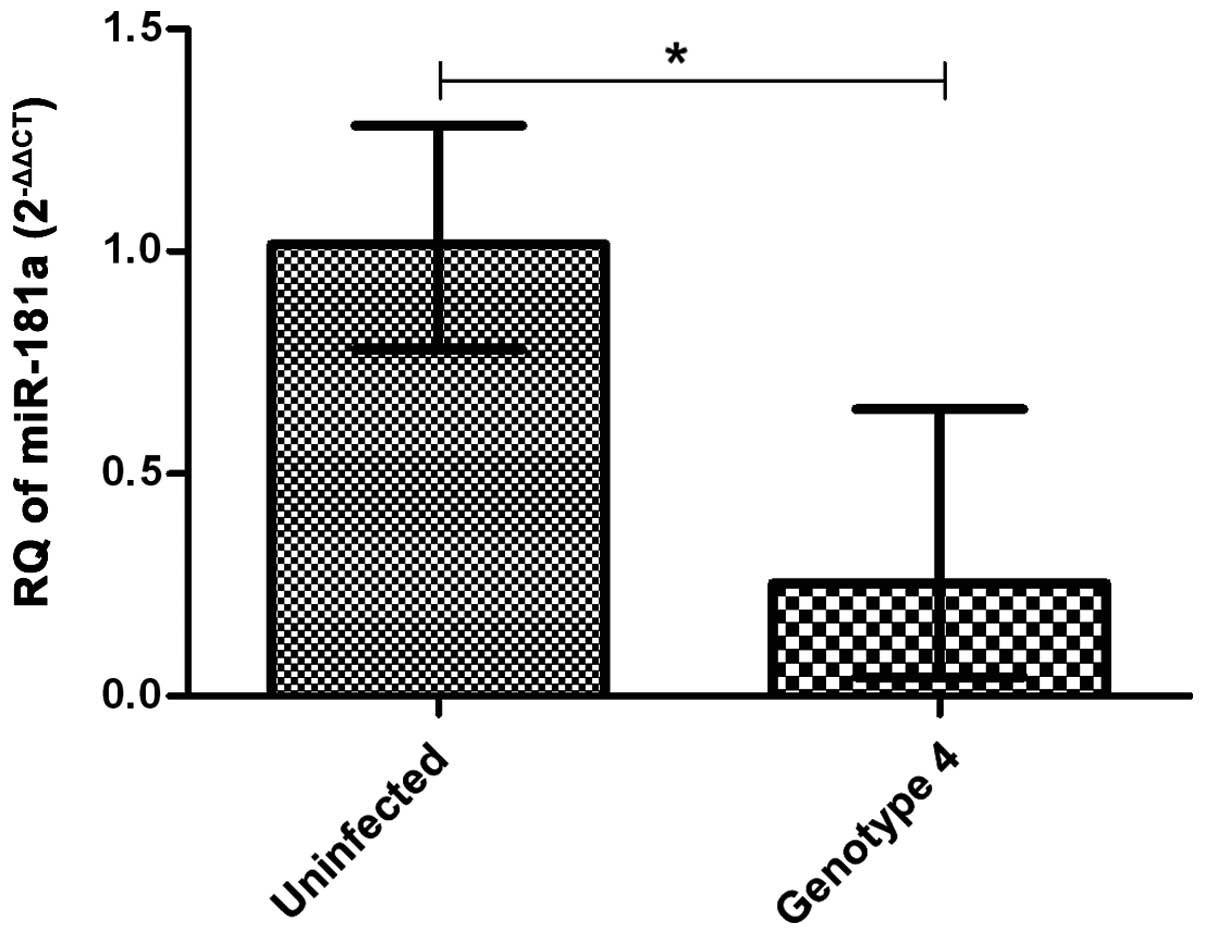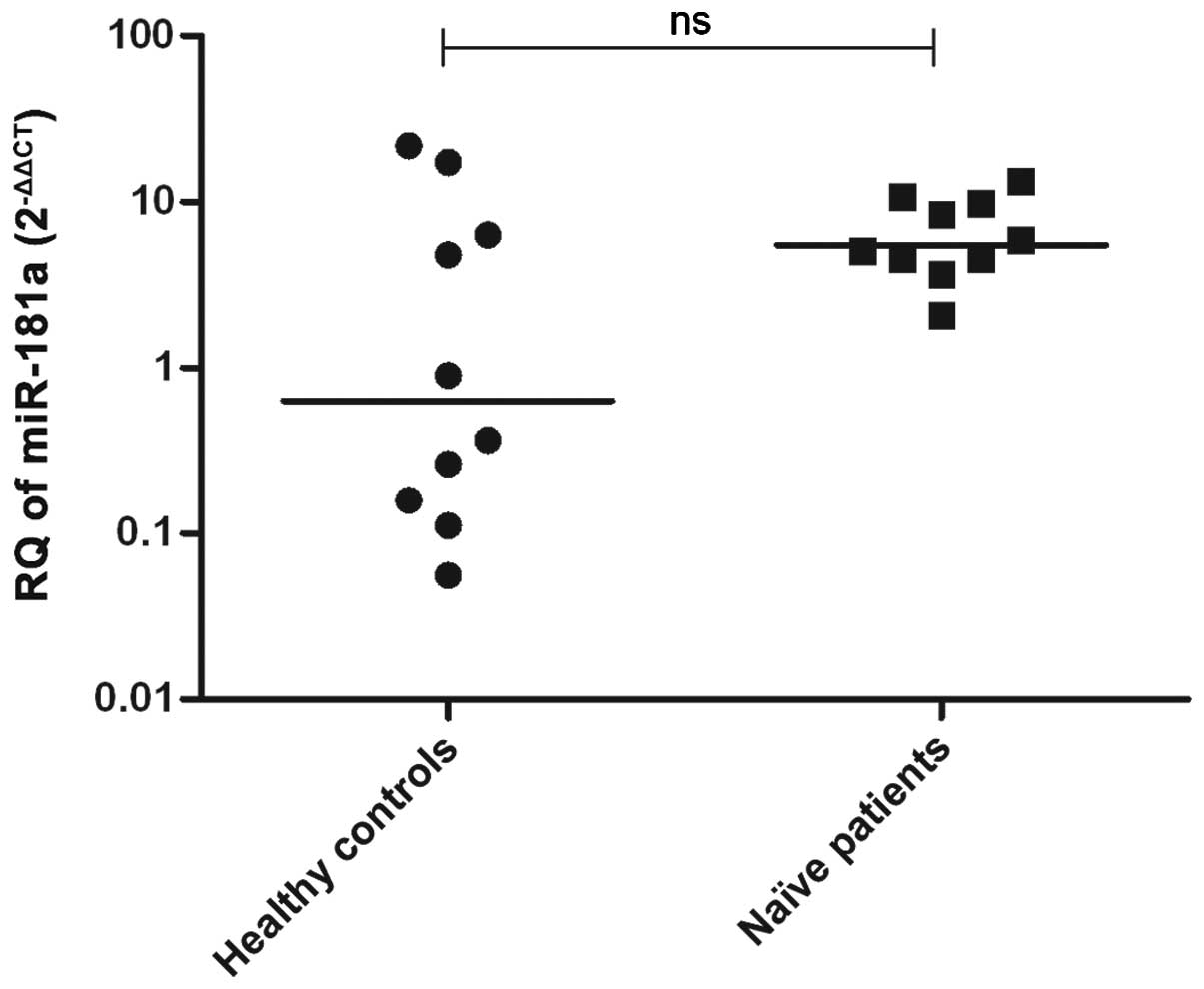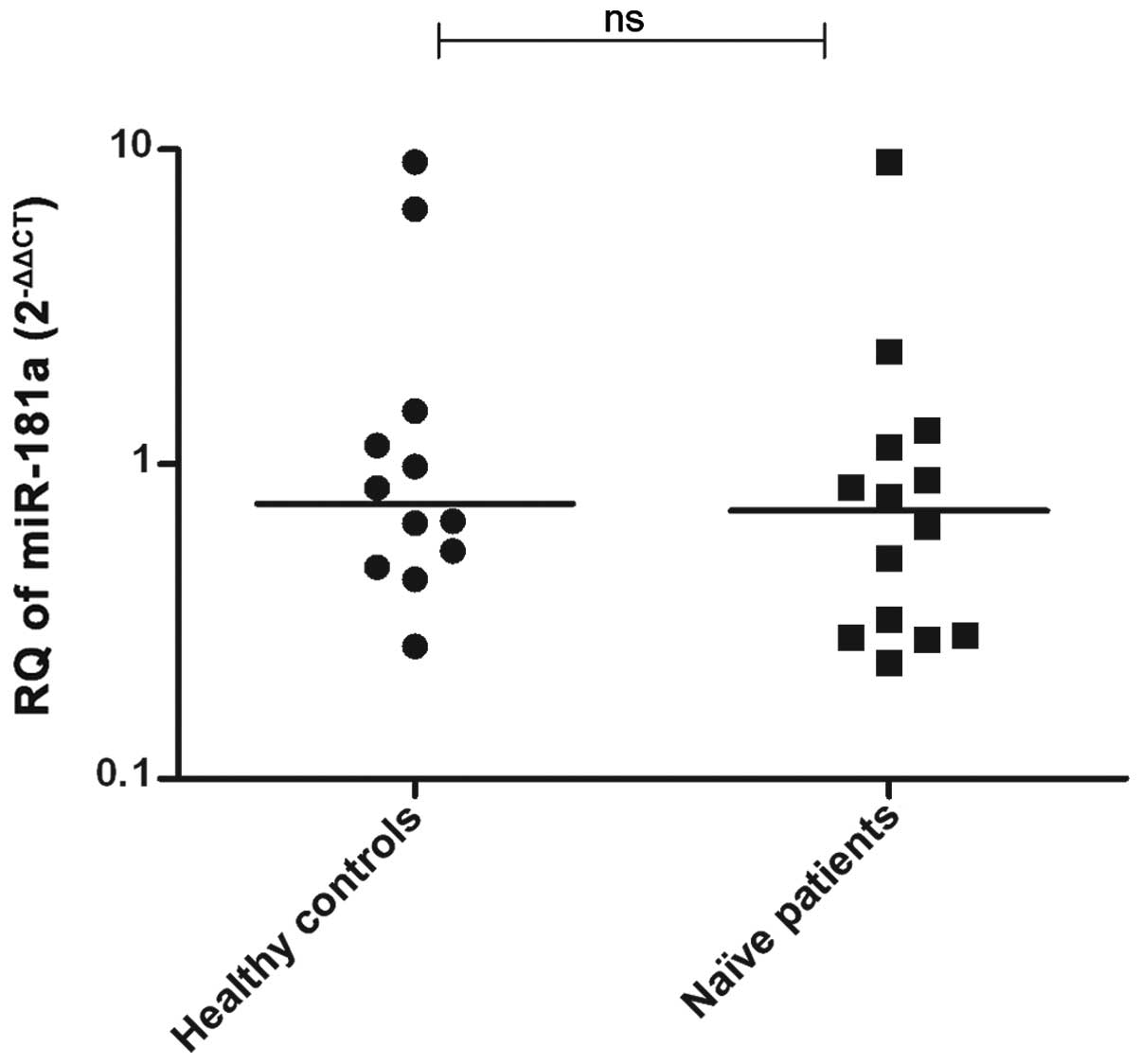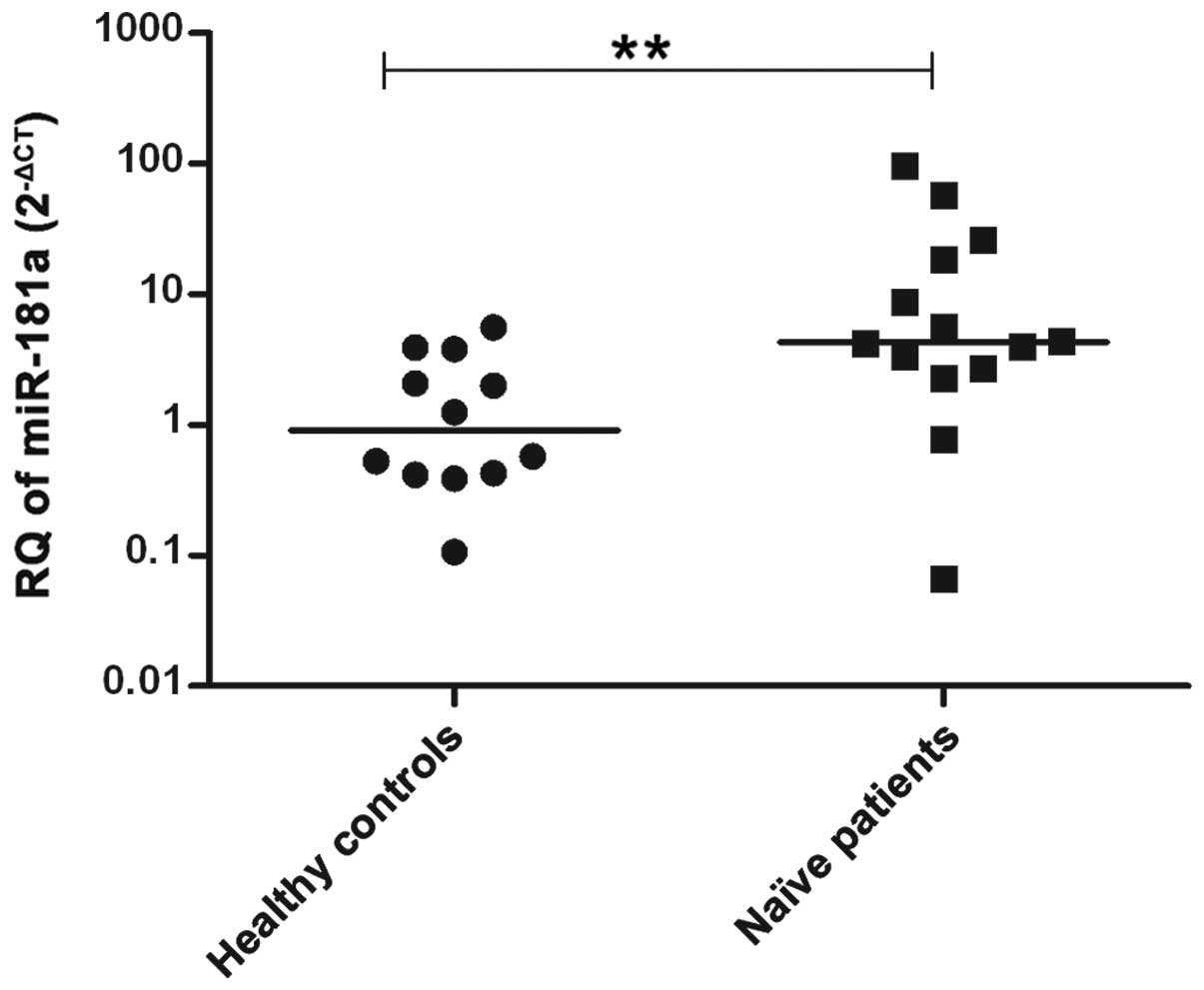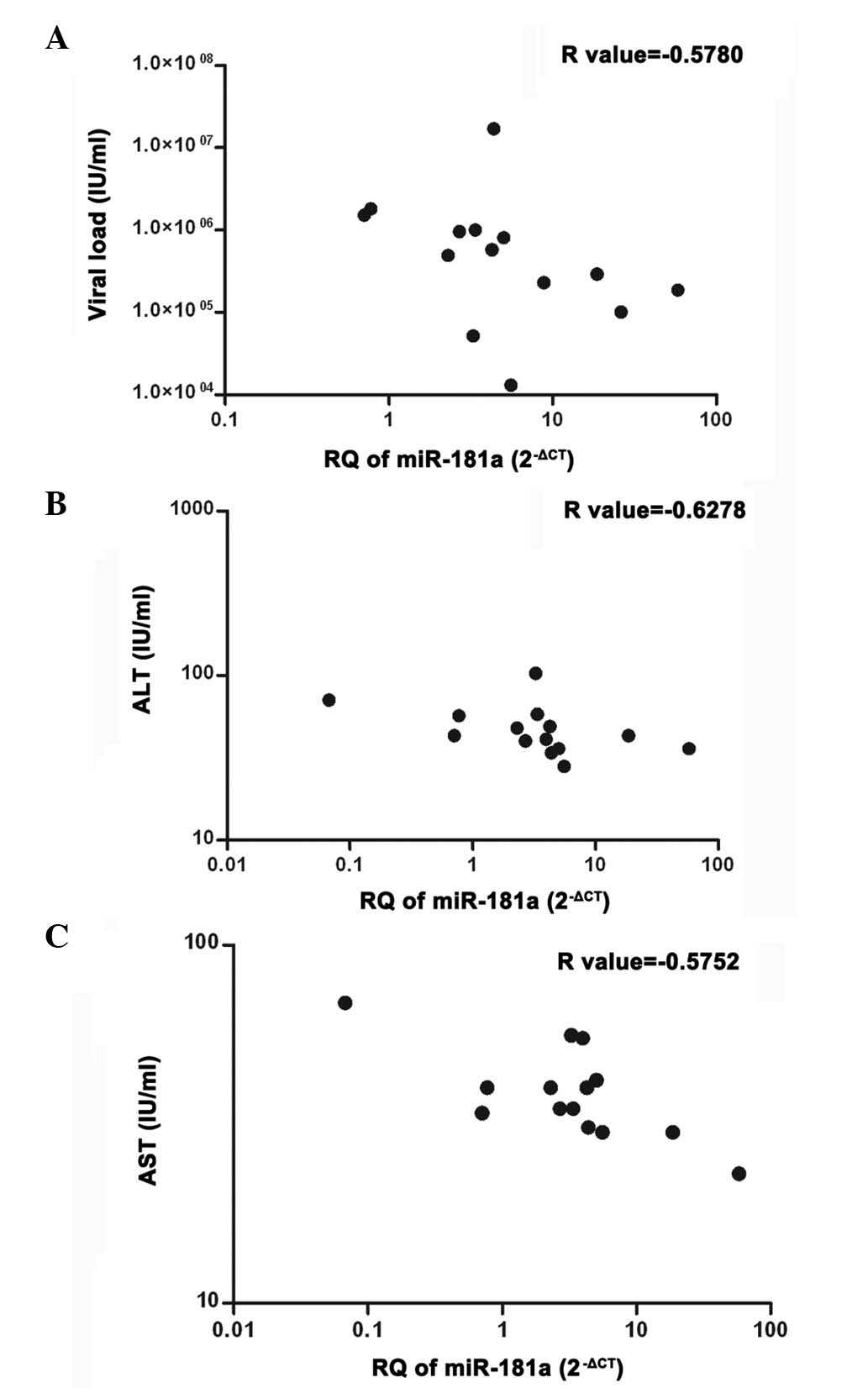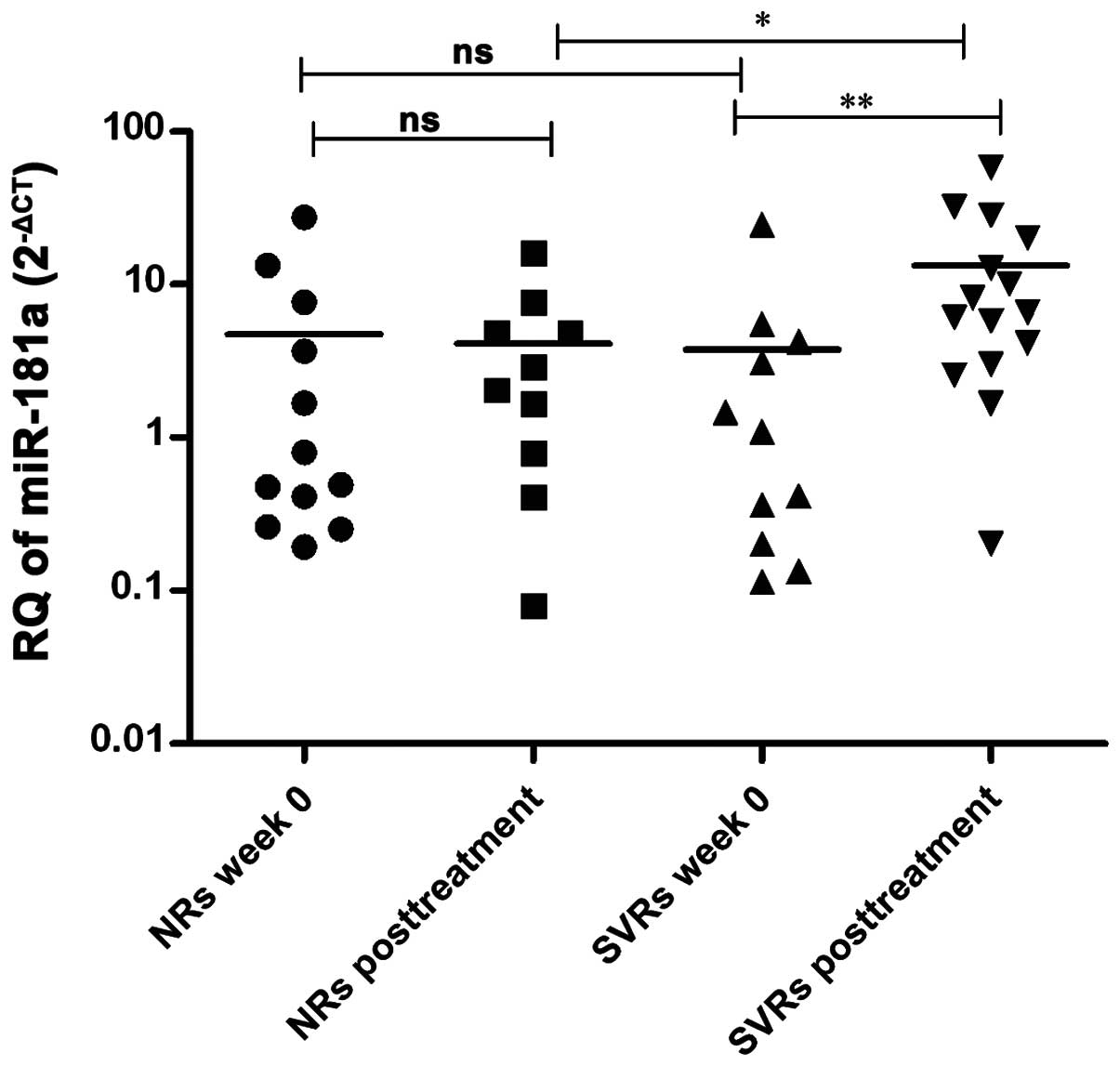Predictive prognostic role of miR‑181a with discrepancy in the liver and serum of genotype 4 hepatitis C virus patients
- Authors:
- Published online on: August 13, 2014 https://doi.org/10.3892/br.2014.343
- Pages: 843-848
Abstract
Introduction
Several studies have investigated the source of circulating microRNAs (miRNAs); however, it is an issue of debate. Previously, it has been indicated that miRNAs are present in the circulation as a result of the release of exosomes from cells (1–3). A study by Esquela-Kerscher and Slack (4) proposed that miRNAs enter the circulation during angiogenesis following their release from tumor cells or as a result of tumor cell death. In addition, another study postulated that miRNAs may also be abundant in the circulation as a result of their release from inflamed organs (5). Changes in circulating miRNA levels do not only result from changes within tumors, but may also be a result of inflammatory reactions or host immune response. Based on this fact, the expression of miRNAs in organs does not always represent their quantity in serum. For example, miR-195 was found to be downregulated in breast cancer tissues (6), whereas its circulating levels were found to be upregulated in breast cancer patients compared to controls (7). In support of this evidence, Waters et al (8) showed that miR-195 and miR-497 were decreased and miR-221 was increased in tumor tissues from murine models of breast cancer compared to healthy tissues, with no difference in the expression of all three miRNAs in the circulation. Additionally, miR-122 was shown to have a low expression in liver (9,10) and high expression in the serum of hepatocellular carcinoma (HCC) patients compared to the controls (11). miR-181a represents another example for this discrepancy, as upregulation of miR-181a was reported in embryonic and epithelial cell adhesion molecule/α-fetoprotein (EpCAM+/AFP+) liver tissues compared to the healthy controls (12), whereas at the serum level no difference in miR-181a expression was observed (13).
miR-181a is an immunoregulatory miRNA (14) that is reported to have its highest relative expression in the thymus, the primary lymphoid organ and site of T lymphocyte maturation (15), highlighting its role in the maturation, sensitivity and selection of T lymphocytes. miR-181a has shown aberrant expression in viral infections, in which it was reported to be downregulated in human papillomavirus-positive cell lines and upregulated in HepG2 cell lines infected with hepatitis B virus (HBV) (16,17). In hepatitis C virus (HCV), a single study was conducted by Liu et al (18) in which a microarray was performed, which showed that infection of human hepatoma cell lines (Huh 7.5.1) with JFH-1 HCV leads to miR-181a downregulation.
From the aforementioned data, there is clear evidence that miR-181a shows aberrant expression in liver tissues that was not mirrored in the serum of HCC patients (8,12,13). Since infection with HCV is a major cause of HCC, the present study aimed to reveal the expression profile of miR-181a in HCV infection and correlate it to the expression reported in HCC. Therefore, miR-181a was screened in serum, liver tissues and peripheral mononuclear cells (PBMCs) of patients infected with genotype 4 (GT4)-HCV, the most prevalent HCV genotype in Egypt, which to the best of our knowledge has never been previously investigated. The study also aimed to associate the serum miR-181a expression with response to the standard therapy used in Egypt, pegylated-interferon/ribavirin (PEG-IFN/RBV) therapy.
Patients and methods
Study subjects
A total of 72 patients chronically infected with HCV and 22 age-matched controls were included in the study. The patients were classified as 24 naïve patients, 11 sustained virological responders (SVRs) pre-treatment, 15 SVRs post-treatment, 12 non-responders (NRs) pre-treatment and 10 NRs post-treatment. All the naïve patients were candidates for PEG-IFN/RBV therapy. The presence of HCV RNA and anti-HCV antibodies in the serum was used to diagnose HCV infection. The patients were determined as negative for the hepatitis B surface antigen. The samples from post-treatment SVRs and NRs were obtained following treatment with weekly injections of PEG-IFN-α and daily oral doses of RBV at Al Kasr Al Ainy School of Medicine, Cairo University (Cairo, Egypt). The controls were healthy volunteers that were all negative for HCV, HBV and HIV infection. The patients and healthy volunteers included in the study provided their written informed consent. All the clinical procedures were performed in compliance with the guidelines of the Institutional Review Board of Al Kasr Al Ainy School of Medicine in Cairo University and in accordance with the ethical standards of the Declaration of Helsinki.
Collection of samples
Peripheral venous blood (8 ml) was collected from each patient and control in the presence of an anticoagulant, EDTA, for isolation of PBMCs. All the samples were processed on the same day and within a few hours after collection. In addition, 2 ml blood samples were collected from patients and healthy controls for serum separation. The liver tissue samples were collected from patients by fine-needle aspiration and healthy liver tissues were obtained during liver transplantation. The samples were directly cryopreserved following biopsy collection until required for use.
Serum separation and isolation of PBMCs
The serum samples were collected in serum separator tubes, centrifuged at 1,500 × g for 10 min and immediately frozen at −80°C until required for use.
PBMCs were isolated using the Ficoll (Axis-Shield PoC AS, Kjelsåsveien, Oslo, Norway) density gradient centrifugation method as previously described (19), and frozen at −80°C until required for use. Cell counting and viability testing were performed using trypan blue.
Genotyping
Genotyping was performed using the Versant® HCV Genotype 2.0 assay (LiPA; Bayer HealthCare, Tarrytown, NY, USA), at the National Cancer Institute, according to the manufacturer’s instructions.
Cell culture
Huh7 cells were maintained in Dulbecco’s Modified Eagle’s medium supplemented with L-glutamine, penicillin/streptomycin and fetal bovine serum.
In vitro transcription and transfection of GT4-HCV full length genome
The intergenotypic recombinant pED435′UTR-NS2/JFH1T8271,T977S encompassing the 5′ untranslated region (UTR) to NS2 region of the GT4a-HCV genome (provided by Professor Jens Bukh) (20) was linerized using the Xba1 restriction enzyme (Thermo Scientific, Waltham, MA, USA) and purified using phenol-chloroform. Confirmation of linearization was performed using gel electrophoresis. Linearized plasmid was in vitro transcribed using the MEGAscript T7 in vitro transcription kit (Ambion, Life Technologies, Carlsbad, CA, USA). The transcribed viral RNA was transfected into the Huh7 cells by lipofection (Superfect; Qiagen, Hilden, Germany). The supernatant containing HCV particles was collected and filtered through 0.45-μm pore size syringe filters for further use.
Infection
Naïve Huh7 cells were inoculated overnight with the filtered supernatant harvested from the HCV RNA-transfected cells.
Total RNA extraction and reverse transcription
Total cellular RNA was extracted from the Huh7 cells, liver biopsies, PBMCs and serum samples under sterile conditions using Biozol (Bioer Technology Co., Ltd., Binjiang Hanchuan, China) according to the manufacturer’s instructions, as first demonstrated by Chomczynski and Sacchi (21). The TaqMan MicroRNA Reverse Transcription kit (Applied Biosystems, Foster City, CA, USA) was subsequently used to reverse transcribe the total extracted RNA into single-stranded complementary DNA according to the manufacturer’s instructions.
Quantification of miRNAs expression
The relative expression of miR-181a (TaqMan miRNA; ID: 000480) was quantified using StepOne Real-Time PCR (Applied Biosystems) using the TaqMan MicroRNA assay (Applied Biosystems). The comparative cycle threshold (CT) method, which involves comparing the CT values of the samples of interest to that of the healthy controls, was used to calculate the amount of miR-181a. In the Huh7 cell lines, liver biopsies and PBMCs, the amount of miRNA was calculated relative to the amount of the reference gene, RNU6B, in the same sample. Reactions, including the controls, were run in duplicates.
Statistical analysis
miRNA expression is represented as relative quantification (RQ). For the Huh7 cells, liver tissues and PBMCs samples, RQ=2−ΔΔCT, whereas for the serum samples, RQ=2−ΔCT, as described previously (22). Mann-Whitney U test was employed to compare miRNA expression and the results are expressed as median. Correlation studies were analyzed using Spearman test. P<0.05 was considered to indicate a statistically significant difference. Analysis and calculations were performed using GraphPad Prism 5.00 software (GraphPad Software, San Diego, CA, USA).
Results
Expression pattern of miR-181a in HCV-infected Huh7 cells
Huh7 cells infected with pED435′UTR-NS2/JFH1T8271,T977S encompassing the GT4a-HCV genome for 24 h showed lower miR-181a expression when compared to uninfected cells (n=4) (P=0.0286) (Fig. 1).
Expression pattern of miR-181a in liver tissues of naïve HCV-infected patients and healthy control subjects
All the samples were found to be infected with GT4-HCV. The miR-181a expression in HCV-infected (n=10) and healthy (n=10) liver tissues was examined using quantitative reverse transcription-polymerase chain reaction. miR-181a showed similar expression in liver tissues of patients and healthy controls (P=0.1431) (Fig. 2).
Expression pattern of miR-181a in PBMCs of naïve HCV-infected patients and healthy control subjects
miR-181a expression was measured in the PBMCs isolated from naïve GT4-HCV-infected patients (n=14) and healthy controls (n=12). No significant difference was observed in miR-181a expression in patients compared to the controls (P=0.4714) (Fig. 3).
Expression pattern of miR-181a in serum of naïve HCV-infected patients compared to healthy control subjects
The miR-181a expression was measured in the serum samples of naïve GT4-HCV-infected patients (n=14) and was compared to the expression in the healthy controls (n=12). miR-181a was found to be significantly upregulated in HCV-infected patients compared to the controls (P=0.0069) (Fig. 4).
Correlation between miR-181a and clinical parameters
The miR-181a expression measured in the serum samples of naïve GT4-HCV-infected patients (n=14) was correlated with viral load and liver transaminases [alanine aminotransferase (ALT) and aspartate aminotransferase (AST)]. A significant negative correlation was observed between miR-181a expression and viral load (P=0.0304) (r=−0.5780), ALT (P=0.0162) (r=−0.6278), as well as AST (P=0.0314) (r=−0.5752) (Fig. 5).
Variation in miR-181a expression in the serum of HCV-infected patients of different response prior and subsequent to IFN therapy
miR-181a expression was assessed in the serum of SVR and NR HCV-infected patients prior (n=11 and 12, respectively) and subsequent to therapy (n=15 and 10, respectively).
No significant difference was observed in the pre-treatment expression of miR-181a in the serum of NR patients compared to post-treatment levels in NRs (P=0.5095) and pre-treatment levels in SVRs (P=0.6891). However, SVR patients showed higher post-treatment levels of miR-181a compared to pre-treatment levels in SVRs (P=0.0075) and post-treatment levels in NRs (P=0.0375) (Fig. 6).
Discussion
miR-181a was found to be highly expressed in HCC embryonic livers and EpCAM+/AFP+ HCC cells isolated from fetal livers compared to adult livers or freshly isolated mature hepatocytes (12), however, its level was similar in the serum of HCC patients and healthy controls (13). Thus far, it is not known whether miR-181a expression in HCV infection, as a major cause of HCC, shows the same discrepancy as reported in HCC patients. Therefore, the present study was interested in investigating the expression of miR-181a in GT4-HCV infection with the aim to examine whether it depicts a correlation to its profile in HCC and to the treatment response with PEG-IFN/RBV therapy, the standard therapy used in Egypt.
In order to examine miR-181a expression in GT4-HCV, Huh7 cells were infected with HCVcc (infectious cell culture HCV model) derived from ED43/JFH1 (provided by Professor Jens Buch). The expression of miR-181a was decreased in the infected Huh7 cells (Fig. 1). This finding exhibits a similarity with a study performed by Liu et al (18), which showed that miR-181a is downregulated in Huh7 cells infected with GT2-HCV (JFH1-HCV). The finding of this study, as well as the present study, confers that miR-181a is downregulated in HCV-infected cell lines irrespective of the genotype. To the best of our knowledge, for the first time the expression pattern of miR-181a in liver biopsies, PBMCs and serum of naïve GT4-HCV-infected patients was investigated. miR-181a expression did not demonstrate variation in liver tissues and PBMCs of the patients compared to the controls (Figs. 2 and 3, respectively). By contrast, there was a significant increase in the serum of patients compared to the controls (Fig. 4). This elevated expression of miR-181a could be a result of released exosomes in the circulation (1–3). Notably, the miR-181a expression pattern in the liver tissues and serum of GT4-HCV-infected patients showed an inverse correlation to its expression pattern in HCC, in which HCC miR-181a was found to be upregulated in liver tissues and normally expressed in the serum of patients (12,13), in contrast to no expression variation in the liver tissues and a significantly increased expression in the serum of HCV-infected patients. Subsequently, whether the expression of miR-181a correlates to the patient clinical parameters [viral load and liver enzymes (ALT and AST)] was examined. A clear finding that serum miR-181a expression of HCV patients is inversely correlated with the level of viremia, as well as liver enzymes (ALT, AST) (Fig. 5), was found. To compare the miR-181a expression pattern among different groups of responders to standard PEG-IFN/RBV treatment, miR-181a was quantified in the serum of pre- and post-treatment SVRs and NRs. Serum pre- and post-treatment expression of miR-181a did not differ in NRs (Fig. 6). Notably, a significant upregulation of miR-181a was found in SVR patients following treatment compared to NR patients and treatment-naïve SVRs, with no difference shown between the groups (SVRs and NRs) prior to therapy (Fig. 6). This is in accordance with a previous study reporting comparable pre-treatment levels of miR-122 in SVRs and NR patients infected with GT1-HCV (23). The expression of miR-181a observed in pre-treatment SVRs and NRs opposes that of several miRNAs depicted to show higher levels in responders compared to in NRs. For example, serum pre-treatment levels of miR-122, the most extensively studied miRNA in HCV, were found to be significantly higher in SVR compared to NR GT2-HCV-infected patients (24). Similarly, pre-treatment levels of miR-122 were reported to be higher in liver tissues of responders compared to NR GT1, 2, 3 and 4 HCV-infected patients (25). Furthermore, GT1, 2 and 3 SVR patients showed high pre-treatment levels of miR-155 in liver tissues and PBMCs, which decreased following viral clearance (26,27).
In conclusion, to the best of our knowledge, the present study demonstrates for the first time, a disparity in the expression of miR-181a in the liver tissues and serum of GT4-HCV-infected patients compared to controls, which is conflicting to the expression pattern of miR-181a reported in HCC (12,13). Additionally, although pre-treatment miR-181a expression did not differentiate between SVRs and NRs, the serum of SVR patients post-treatment was shown to exhibit a significant upregulation of miR-181a compared to NR patients and treatment-naïve SVRs, which indicates viral eradication. Thus, the data show that the upregulation of miR-181a in the serum of HCV patients is an indication of good prognosis and any decrease during follow-up may be an early marker for progression to HCC.
Acknowledgements
The authors would like to acknowledge Professor Jens Bukh (Copenhagen University Hospital, Hvidovre, Denmark) and Professor Takaji Wakita (Department of Virology II, National Institute of Infectious Diseases, Tokyo, Japan) for the pED435′UTR-NS2/JFH1T8271,T977S viral vector.
References
|
Lima LG, Chammas R, Monteiro RQ, Moreira ME and Barcinski MA: Tumor-derived microvesicles modulate the establishment of metastatic melanoma in a phosphatidylserine-dependent manner. Cancer Lett. 283:168–175. 2009. View Article : Google Scholar : PubMed/NCBI | |
|
Cocucci E, Racchetti G and Meldolesi J: Shedding microvesicles: artefacts no more. Trends Cell Biol. 19:43–51. 2009. View Article : Google Scholar : PubMed/NCBI | |
|
Ghosh AK, Secreto CR, Knox TR, Ding W, Mukhopadhyay D and Kay NE: Circulating microvesicles in B-cell chronic lymphocytic leukemia can stimulate marrow stromal cells: implications for disease progression. Blood. 115:1755–1764. 2010. View Article : Google Scholar | |
|
Esquela-Kerscher A and Slack FJ: Oncomirs - microRNAs with a role in cancer. Nat Rev Cancer. 6:259–269. 2006. View Article : Google Scholar | |
|
Zhang Q, Pu R, Du Y, Han Y, Su T, Wang H and Cao G: Non-coding RNAs in hepatitis B or C-associated hepatocellular carcinoma: potential diagnostic and prognostic markers and therapeutic targets. Cancer Lett. 321:1–12. 2012. View Article : Google Scholar : PubMed/NCBI | |
|
Li D, Zhao Y, Liu C, et al: Analysis of miR-195 and miR-497 expression, regulation and role in breast cancer. Clin Cancer Res. 17:1722–1730. 2011. View Article : Google Scholar : PubMed/NCBI | |
|
Heneghan HM, Miller N, Lowery AJ, Sweeney KJ, Newell J and Kerin MJ: Circulating microRNAs as novel minimally invasive biomarkers for breast cancer. Ann Surg. 251:499–505. 2010. View Article : Google Scholar : PubMed/NCBI | |
|
Waters PS, McDermott AM, Wall D, et al: Relationship between circulating and tissue microRNAs in a murine model of breast cancer. PLoS One. 7:e504592012. View Article : Google Scholar : PubMed/NCBI | |
|
Kutay H, Bai S, Datta J, et al: Downregulation of miR-122 in the rodent and human hepatocellular carcinomas. J Cell Biochem. 99:671–678. 2006. View Article : Google Scholar : PubMed/NCBI | |
|
Gramantieri L, Ferracin M, Fornari F, et al: Cyclin G1 is a target of miR-122a, a microRNA frequently down-regulated in human hepatocellular carcinoma. Cancer Res. 67:6092–6099. 2007. View Article : Google Scholar : PubMed/NCBI | |
|
Xu J, Wu C, Che X, et al: Circulating microRNAs, miR-21, miR-122, and miR-223, in patients with hepatocellular carcinoma or chronic hepatitis. Mol Carcinog. 50:136–142. 2011. View Article : Google Scholar : PubMed/NCBI | |
|
Ji J, Yamashita T, Budhu A, et al: Identification of microRNA-181 by genome-wide screening as a critical player in EpCAM-positive hepatic cancer stem cells. Hepatology. 50:472–480. 2009. View Article : Google Scholar : PubMed/NCBI | |
|
Zhan MX, Li Y, Hu BS, et al: Expression of serum microRNAs (miR-222, miR-181, miR-216) in human hepatocellular carcinoma and its clinical significance. Zhonghua Yi Xue Za Zhi. 93:1830–1832. 2013.(In Chinese). | |
|
Li QJ, Chau J, Ebert PJ, et al: miR-181a is an intrinsic modulator of T cell sensitivity and selection. Cell. 129:147–161. 2007. View Article : Google Scholar : PubMed/NCBI | |
|
Chen CZ, Li L, Lodish HF and Bartel DP: MicroRNAs modulate hematopoietic lineage differentiation. Science. 303:83–86. 2004. View Article : Google Scholar : PubMed/NCBI | |
|
Liu Y, Zhao JJ, Wang CM, et al: Altered expression profiles of microRNAs in a stable hepatitis B virus-expressing cell line. Chin Med J (Engl). 122:10–14. 2009.PubMed/NCBI | |
|
Wald AI, Hoskins EE, Wells SI, Ferris RL and Khan SA: Alteration of microRNA profiles in squamous cell carcinoma of the head and neck cell lines by human papillomavirus. Head Neck. 33:504–512. 2011. View Article : Google Scholar : PubMed/NCBI | |
|
Liu X, Wang T, Wakita T and Yang W: Systematic identification of microRNA and messenger RNA profiles in hepatitis C virus-infected human hepatoma cells. Virology. 398:57–67. 2010. View Article : Google Scholar : PubMed/NCBI | |
|
El-Ekiaby, Hamdi N, Negm M, et al: Repressed induction of interferon-related microRNAs miR-146a and miR-155 in peripheral blood mononuclear cells infected with HCV genotype 4. FEBS Open Bio. 2:179–186. 2012. View Article : Google Scholar : PubMed/NCBI | |
|
Li YP, Gottwein JM, Scheel TK, Jensen TB and Bukh J: MicroRNA-122 antagonism against hepatitis C virus genotypes 1–6 and reduced efficacy by host RNA insertion or mutations in the HCV 5′ UTR. Proc Natl Acad Sci USA. 108:4991–4996. 2011.PubMed/NCBI | |
|
Chomczynski P and Sacchi N: Single-step method of RNA isolation by acid guanidinium thiocyanate-phenol-chloroform extraction. Anal Biochem. 162:156–159. 1987. View Article : Google Scholar : PubMed/NCBI | |
|
Hu Z, Chen X, Zhao Y, et al: Serum microRNA signatures identified in a genome-wide serum microRNA expression profiling predict survival of non-small-cell lung cancer. J Clin Oncol. 28:1721–1726. 2010. View Article : Google Scholar : PubMed/NCBI | |
|
Köberle V, Waidmann O, Kronenberger B, et al: Serum microRNA-122 kinetics in patients with chronic hepatitis C virus infection during antiviral therapy. J Viral Hepat. 20:530–535. 2013.PubMed/NCBI | |
|
Su TH, Liu CH, Liu CJ, et al: Serum microRNA-122 level correlates with virologic responses to pegylated interferon therapy in chronic hepatitis C. Proc Natl Acad Sci USA. 110:7844–7849. 2013. View Article : Google Scholar : PubMed/NCBI | |
|
Sarasin-Filipowicz M, Krol J, Markiewicz I, Heim MH and Filipowicz W: Decreased levels of microRNA miR-122 in individuals with hepatitis C responding poorly to interferon therapy. Nat Med. 15:31–33. 2009. View Article : Google Scholar : PubMed/NCBI | |
|
Bala S, Tilahun Y, Taha O, Alao H, Kodys K, Catalano D and Szabo G: Increased microRNA-155 expression in the serum and peripheral monocytes in chronic HCV infection. J Transl Med. 10:1512012. View Article : Google Scholar : PubMed/NCBI | |
|
Zhang Y, Wei W, Cheng N, Wang K, Li B, Jiang X and Sun S: Hepatitis C virus-induced up-regulation of microRNA-155 promotes hepatocarcinogenesis by activating Wnt signaling. Hepatology. 56:1631–1640. 2012. View Article : Google Scholar : PubMed/NCBI |



